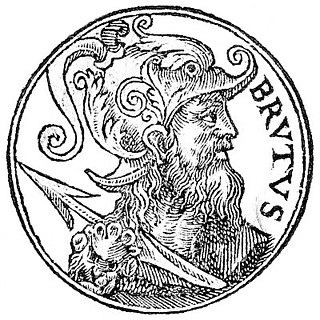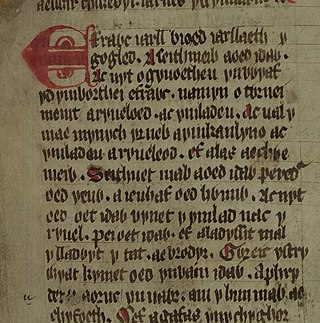
Geoffrey of Monmouth was a Catholic cleric from Monmouth, Wales, and one of the major figures in the development of British historiography and the popularity of tales of King Arthur. He is best known for his chronicle The History of the Kings of Britain which was widely popular in its day, being translated into other languages from its original Latin. It was given historical credence well into the 16th century, but is now considered historically unreliable.

Uther Pendragon (Brittonic), also known as King Uther, was a legendary King of the Britons and father of King Arthur.

Brutus, also called Brute of Troy, is a mythical British king. He is described as a legendary descendant of the Trojan hero Aeneas, known in medieval British legend as the eponymous founder and first king of Britain. This legend first appears in the Historia Brittonum, an anonymous 9th-century historical compilation to which commentary was added by Nennius, but is best known from the account given by the 12th-century chronicler Geoffrey of Monmouth in his Historia Regum Britanniae.

Lud, according to Geoffrey of Monmouth's pseudohistorical History of the Kings of Britain and related medieval texts, was a king of Britain in pre-Roman times who founded London and was buried at Ludgate. He was the eldest son of Geoffrey's King Heli, and succeeded his father to the throne. He was succeeded, in turn, by his brother Cassibelanus. Lud may be connected with the Welsh mythological figure Lludd Llaw Eraint, earlier Nudd Llaw Eraint, cognate with the Irish Nuada Airgetlám, a king of the Tuatha Dé Danann, and the Brittonic god Nodens. However, he was a separate figure in Welsh tradition and is usually treated as such.

Beli Mawr was an ancestor figure in Middle Welsh literature and genealogies. He is the father of Cassivellaunus, Arianrhod, Lludd Llaw Eraint, Llefelys, and Afallach. In certain medieval genealogies, he is listed as the son or husband of Anna, cousin of Mary, mother of Jesus. According to the Welsh Triads, Beli and Dôn were the parents of Arianrhod, but the mother of Beli's other children—and the father of Dôn's other children—is not mentioned in the medieval Welsh literature. Several royal lines in medieval Wales traced their ancestry to Beli. The Mabinogi names Penarddun as a daughter of Beli Mawr, but the genealogy is confused; it is possible she was meant to be his sister rather than daughter.

Tasciovanus was a historical king of the Catuvellauni tribe before the Roman conquest of Britain.
Rud Hud Hudibras was a legendary king of the Britons as recounted by Geoffrey of Monmouth. He came to power in 974BC.
Rivallo was a legendary king of the Britons as accounted by Geoffrey of Monmouth. He came to power in 817BC.

Gurgustius was a legendary king of the Britons as accounted by Geoffrey of Monmouth. He came to power in 788BC.
Sisillius I was a legendary king of the Britons as accounted by Geoffrey of Monmouth. He came to power in 753 BC.
Gerennus was a legendary king of the Britons as recounted by Geoffrey of Monmouth. He came to power in 275BC.
Millus was a legendary king of the Britons as recounted by Geoffrey of Monmouth. His father was King Catellus and he was succeeded by his son, Porrex II.
Porrex II was a legendary king of the Britons as recounted in Geoffrey of Monmouth's Historia Regum Britanniae. He came to power in 257 BC.

Historia regum Britanniae, originally called De gestis Britonum, is a pseudohistorical account of British history, written around 1136 by Geoffrey of Monmouth. It chronicles the lives of the kings of the Britons over the course of two thousand years, beginning with the Trojans founding the British nation and continuing until the Anglo-Saxons assumed control of much of Britain around the 7th century. It is one of the central pieces of the Matter of Britain.
Arvirargus or Arviragus was a legendary British king of the 1st century AD, possibly based upon a real person. A shadowy historical Arviragus is known only from a cryptic reference in a satirical poem by Juvenal, in which a giant turbot presented to the Roman emperor Domitian is said to be an omen that "you will capture some king, or Arviragus will fall from his British chariot-pole".
Caradocus, according to Geoffrey of Monmouth's Historia regum Britanniae, a pseudohistorical account of the kings of the Britons, was the duke of Cornwall under the reign of Octavius, who became king of Cornwall and died during the Emperor Magnus Maximus' reign.

Dionotus was a legendary king of Cornwall in Geoffrey of Monmouth's Historia regum Britanniae, an account of the rulers of Britain based on ancient Welsh sources and disputed by many historians. Dionotus succeeding his brother Caradocus, and was regent of Britain during the campaigns in Gaul of Emperor Magnus Maximus. The curious thing about this king is that the Welsh chronicles, which parallel most of Geoffrey of Monmouth's book, do not mention this king by name. However, Geoffrey uses Latin versions of Welsh names so he could be referring to Dynod, duke of Cornwall, or Anwn Dynod, Maximus's own son.

Peredur is the name of a number of men from the boundaries of history and legend in sub-Roman Britain. The Peredur who is most familiar to a modern audience is the character who made his entrance as a knight in the Arthurian world of Middle Welsh prose literature.
Mandubracius or Mandubratius was a king of the Trinovantes of south-eastern Britain in the 1st century BC.

Jago was a legendary king of the Britons according to Geoffrey of Monmouth. He was the nephew of Gurgustius, succeeded his cousin Sisillius I to the throne and was succeeded by Sissillius' son Kimarcus. Geoffrey has nothing more to say of him.










